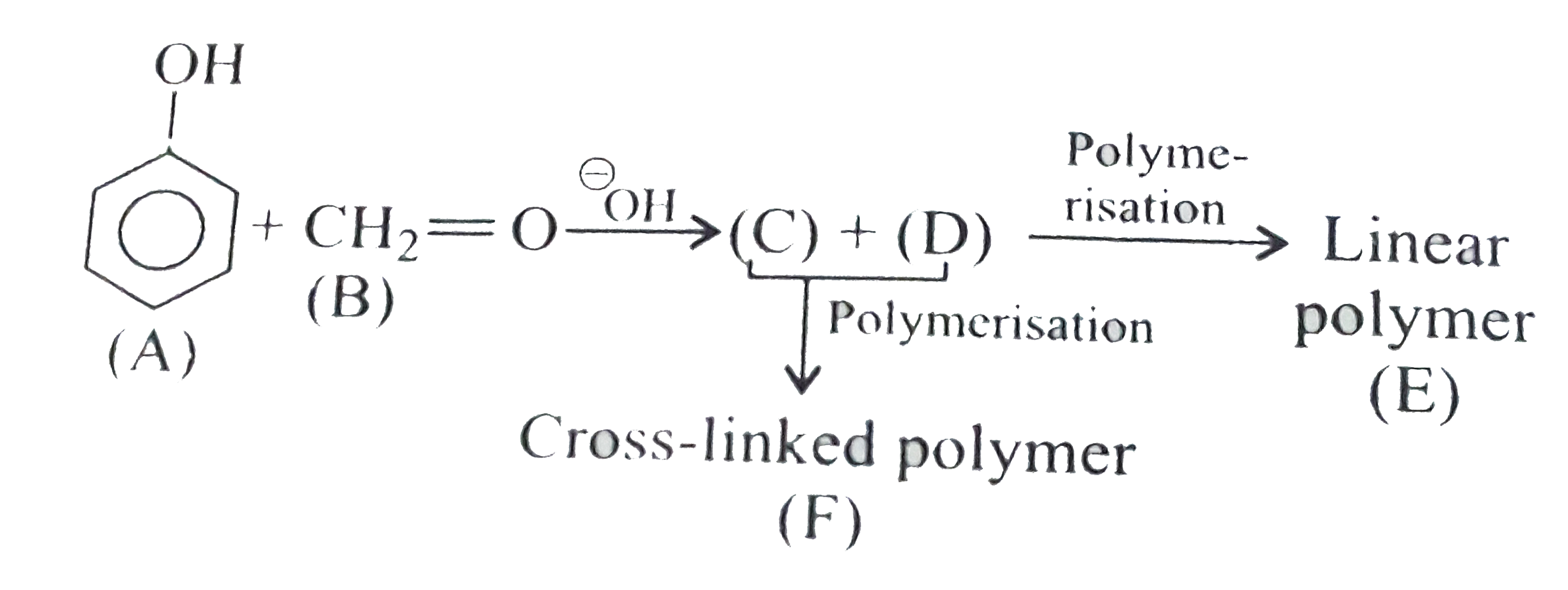What are cross - linked polymers? Give one example of this type.
Step-by-Step Solution:
1. Definition of Cross-Linked Polymers:
- Cross-linked polymers are defined as polymers where linear polymer chains are interconnected or linked together to form a three-dimensional network structure. This linking can occur through various types of bonds, such as covalent bonds.
2. Structure of Cross-Linked Polymers:
- In cross-linked polymers, the linear chains are not just free-standing; they are chemically bonded at various points, creating a network that provides structural integrity and stability. This three-dimensional structure is what distinguishes cross-linked polymers from linear polymers.
3. Example of Cross-Linked Polymer:
- A well-known example of a cross-linked polymer is Bakelite. Bakelite is formed from the polymerization of phenol and formaldehyde. The reaction leads to a network structure where the phenol molecules are interconnected through methylene bridges (–CH2–) created by the formaldehyde.
4. Formation of Bakelite:
- The process involves the reaction of phenol with formaldehyde, where the hydroxyl (–OH) groups of phenol react with formaldehyde to form methylene linkages. This results in a three-dimensional cross-linked structure that is hard and infusible.
Conclusion:
Cross-linked polymers are characterized by their three-dimensional network structure formed by the interconnection of linear polymer chains. Bakelite, a polymer made from phenol and formaldehyde, serves as a prime example of this type of polymer.
---
- Cross-linked polymers are defined as polymers where linear polymer chains are interconnected or linked together to form a three-dimensional network structure. This linking can occur through various types of bonds, such as covalent bonds.
- In cross-linked polymers, the linear chains are not just free-standing; they are chemically bonded at various points, creating a network that provides structural integrity and stability. This three-dimensional structure is what distinguishes cross-linked polymers from linear polymers.
- A well-known example of a cross-linked polymer is Bakelite. Bakelite is formed from the polymerization of phenol and formaldehyde. The reaction leads to a network structure where the phenol molecules are interconnected through methylene bridges (–CH2–) created by the formaldehyde.
- The process involves the reaction of phenol with formaldehyde, where the hydroxyl (–OH) groups of phenol react with formaldehyde to form methylene linkages. This results in a three-dimensional cross-linked structure that is hard and infusible.
Cross-linked polymers are characterized by their three-dimensional network structure formed by the interconnection of linear polymer chains. Bakelite, a polymer made from phenol and formaldehyde, serves as a prime example of this type of polymer.
Topper's Solved these Questions
- POLYMERSBook:MODERN PUBLICATIONChapter:POLYMERSExercise:NCERT FILE (NCERT)(In - text Question)
Explore 6 Videos
- POLYMERSBook:MODERN PUBLICATIONChapter:POLYMERSExercise:NCERT FILE (NCERT)(Textbook Exercises)
Explore 20 Videos
- POLYMERSBook:MODERN PUBLICATIONChapter:POLYMERSExercise:Practice problems
Explore 3 Videos
- ORGANIC COMPOUNDS CONTAINING NITROGEN Book:MODERN PUBLICATIONChapter:ORGANIC COMPOUNDS CONTAINING NITROGEN Exercise:UNIT PRACTICE TEST
Explore 5 Videos
- SOLID STATEBook:MODERN PUBLICATIONChapter:SOLID STATEExercise:UNIT PRACTICE TEST
Explore 13 Videos
Similar Questions
Knowledge Check

The cross-linked polymer(F)is:AResolBNovolacCBakeliteDDecron
Differentiate between molecular structures and behaviours of thermoplastic and thermosetting polymers. Give one example of each type.
View SolutionWhat are emulsions ? What are their different types ? Give one example of each type.
View SolutionWhat are homopolymers and co-polymers ? Give one example of each
View SolutionDifferentiate between the molecular structures and behaviour of thermoplastic and thermosetting polymers. Give one example of each type
View Solution(i) What are thermosetting polymers ? Give one example
(ii) Give chemical name of teflon
View SolutionWhat are biodegradable polymers ? Give two examples.
View SolutionWhat are biodegradable polymers ? Give two examples.
View Solution

